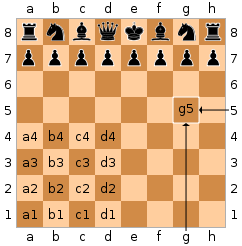
Algebraic notation is the standard method for recording and describing the moves in a game of chess. It is based on a system of coordinates to uniquely identify each square on the board.[1] It is now almost universally used by books, magazines, newspapers and software, and is the only form of notation recognized by FIDE, the international chess governing body.
An early form of algebraic notation was invented by the Syrian player Philip Stamma in the 18th century. In the 19th century, it came into general use in German chess literature, and was subsequently adopted in Russian chess literature. In English-speaking countries, the parallel method of descriptive notation was generally used in chess publications until the 1980s. Similar descriptive systems were in use in Spain and France. A few players still use descriptive notation, but it is no longer recognized by FIDE.
The term "algebraic notation" may be considered a misnomer, as the system is unrelated to algebra.[1]
- ^ a b Hooper, David; Whyld, Kenneth (1996) [First pub. 1992]. "standard notation". The Oxford Companion to Chess (2nd ed.). Oxford University Press. p. 389. ISBN 0-19-280049-3.